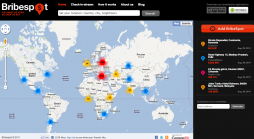Bribespot is a mobile app for Android that allows people to submit reports of corruption and bribes. People can also submit reports on a website and instances are plotted on a map using Google maps API.
In March 2011, Artas Bartas and a team of people from Estonia, Finland, and Lithuania developed the app at Garage48, an event where participants try to pitch and develop an app within 48 hours. Bartas is familiar with issues of corruption; prior to Bribespot, he worked for the UN development program coordinating anti-corruption projects. And, unfortunately, there is demand for an app like Bribespot.
The app has been downloaded 600 times. On the site, about 700 total reports have been submitted and visualized, from around the world.
Bribespot adoption and use has been widespread in Lithuania. Bribespot staff are based in the country and the service has received media attention. There are also many active users in Romania, where the service has been picked up by blogs and web portals. In Romania, many people use the app regularly, Bartas said, which might indicate persistent issues of corruption.
One example from Lithuania is posted on the Bribespot site, in which an individual was asked for 200 USD for a speeding infraction. Another example from Poland reports a bribe for 25 EUR: Traffic cop stopped car. Suggested "half the fine" but first made sure his radiotelephone was off.
A chief success for Bribespot is its simplicity. “The app itself makes sense,” Bartas said. “It is easy to explain.” It is immediately obvious what kind of app it is and how people are supposed to use it, he said.
Partnerships with Others
Organizations have contacted Bartas about Bribespot, asking if there are ways to incorporate the service into their work. Currently, Bribespot is working with Transparency International Lithuania to develop a simplified, web-based version.
Of concern for TI Lithuania, Bartas said, are issues of slander and misrepresentation in corruption reports. So, the organization is focusing on collecting more information from users to verify reports and reach out to those who submit them.
Accuracy and Verification
To help verify reports and strengthen accuracy, Bribespot staff manually check all incoming reports. First, reports should state a specific instance of a bribe. Second, no names or specific accusations against a particular individual are allowed; these are edited out. About 2 percent of incoming reports are inappropriate and deleted.
Bribespot also monitors how many reports are submitted from a unique phone. “If we see that there is strange activity or someone is very adamant about posting as many reports as possible, we could disable that person,” Bartas said, though they have not had to do this yet.
Bribespot further prevents misuse by installing limits: there is a maximum number of reports that someone can submit in a day via the app, and users have to wait 40 minutes to submit a second report. On the website, anyone can flag reports.
Mobile Security Issues
Bribespot has “thought a lot about security,” Bartas said. For instance, what happens if a government agency or official forces the service to hand over its database? Or what happens if the system is hacked? Further, how do you make sure that Bribespot users can not be tracked?
With the Bribespot app, the service collects only the mobile phone unique identifier, or IMEI number. (See this SaferMobile risk primer for more on IMEI numbers and security risks.) This information is captured to help distinguish if the same phone is submitting reports over and over. No other information is captured in the process -- no name or username, no phone number.
The unique identifier is then stored in an encrypted Bribespot database. Aleksandr Tkachenko, technical manager at Bribespot, explained that a standard hashing algorithm is used to provide basic security for the IMEI numbers in the event someone gets access to the servers.
But, this does raise issues, specifically in countries with more stringent mobile phone registration requirements, where a unique identifier may indeed be tied to personal information.
Physical access to a phone is another threat -- mobile phones are easily lost, stolen, or taken. (See this primer for more.) With Bribespot, submitted reports and history of submission are not stored within the app. There is no password or login information required to use this app, so, in the case of physical access to a phone, this information is also not retrievable from the app itself.
It is because of security issues that the app was not developed for SMS delivery on basic feature phones. With SMS, anonymity decreases, and makes it easier for mobile network operators or others to identify those who submit corruption reports.
A Fundamental Misconception, and Opportunity for Others
Bartas said that Bribespot often gets asked, what happens next? Users will submit reports and ask to be notified when something is done with the report.
Bribespot does not exist to take action on submitted reports; the primary aim is not to see that people are sentenced or that issues are taken to court. “There is a fundamental misconception,” Bartas said. “If an agency within a country fails to tackle the issue of corruption, I don’t think five technical people will be able to step in their shoes and correct the social ills that have been going on for decades.”
What is the aim of Bribespot? To visualize the corruption that is happening, to act as facilitators on the technical side, and to make as many aware of the service as possible. Second, Bribespot wants to make it easy for others to act upon Bribespot information, such as anti-corruption organizations or investigative journalists.
An iPhone version of Bribespot is expected in October.


Post new comment